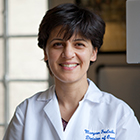Optimizing Hydroxyurea Use—at Home and Around the World

Hydroxyurea can help children with sickle cell disease experience fewer painful episodes. That’s good, but it’s not enough for pediatric hematologists at Cincinnati Children’s. With the support of two large grants and collaborators from throughout the United States and the world, they are refining a personalized dosing protocol and exploring ways to make the drug available in developing countries where the disease burden is greatest.
Greater accuracy, less titration
A personalized dosing protocol was presented at the American Society of Hematology National Meeting in December 2017. It is part of the Cincinnati Children’s Therapeutic Response Evaluation and Adherence Trial (TREAT), a prospective study that uses a population pharmacokinetics (PK) model to simplify hydroxyurea dosing. Principal investigator Patrick McGann, MD, MS, recently received a $1 million dollar grant from the Doris Duke Charitable Foundation to validate this unique and innovative treatment model in several pediatric sickle cell centers in the Midwest.
“The PK model was developed in collaboration with the medical center’s clinical pharmacology team, led by Dr. Sander Vinks, to create an individualized profile for accurate dosing so that we can avoid the tedious and time-consuming process of titrating to the maximum tolerated dose,” says Russell Ware, MD, PhD, director of the Division of Hematology at Cincinnati Children’s. “For these young study participants, their treatment responses are much higher than those achieved with traditional weight-based dosing.”
Many of the children enrolled in the TREAT study are under two years of age, Ware notes. “In our clinic we have been using hydroxyurea in progressively younger patients at higher doses, and finding that infants and toddlers respond even better than older patients do,” he says. “Using hydroxyurea at optimal doses when children are very young, before their bodies stop producing fetal hemoglobin (HbF), is very advantageous, since it helps protect them against painful episodes, long-term complications and organ damage.”
Updated results were presented at the American Society of Hematology National Meeting in December 2018.
Expanding the use of hydroxyurea globally
Believing that all patients with sickle cell disease should have access to the most effective therapies available, Ware and colleagues at Cincinnati Children’s began a prospective, multi-center trial called REACH (Realizing Effectiveness Across Continents with Hydroxyurea). The study, funded by a $3.7 million dollar grant from the National Institutes of Health, is assessing the feasibility, safety and benefits of hydroxyurea in sub-Saharan Africa. In collaboration with African investigators, the research team has enrolled 600 children at four clinical sites, which are located in Angola, the Democratic Republic of Congo, Kenya and Uganda. Ware’s team presented initial, exciting results of the trial in a plenary talk at the annual American Society of Hematology Meeting, and the results were published by the New England Journal of Medicine in December 2018.
Closer to home, a multidisciplinary team of providers cares for about 300 children at the Comprehensive Sickle Cell Center at Cincinnati Children’s. There, Clinical Director Charles Quinn, MD, MS, in collaboration with Center Director Punam Malik, MD, leads a team of physicians, nurses, social workers and other providers to help children with sickle cell disease, thalassemia and other hemoglobin disorders thrive in the midst of significant health challenges. In addition to providing patient care, Malik is leading an ongoing gene therapy trial that has seen early success in the treatment of sickle cell disease.

